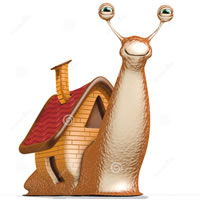
An interesting Swedish I learnt recently is snigelhus, which means shell, or literally “snail house”. Snigel is a snail or slug, and hus is house, case or residence.
The word snigel comes from the Old Norse snigill (snail), from the Proto-Germanic *snagila (snail), from the Proto-Indo-European *sneg- (to crawl, creep; creeping thing), which is also the root of the English words snail and snake.
Some related words include:
- snigelfart = snail’s pace, e.g. att gå framåt i snigelfart = to proceed at a snail’s pace
- snigelpost = snail mail
- snigelaktig = snail-like
- snigelgång = snail time
- snigeltempo = snail pace
Another name for snail is snigel med skal (snail with shell), and another name for slug is snigel utan skal (snail without shell).
So it seems that skal is another word for shell. It also means coat, paring, rind, jacket or peel. A snail’s shell is not snigels snigelhus but snigelskal.
Other Swedish words for shell include:
- balja = shell, tub, tubful, bowl, pod
- snäcka = shell, helix
- musselskal – clamshell, scallop, shell
- snäckskal = scallop, scollop, seashell, shell
- ärtskida = shell
- ärtbalja = shell
Sources: bab.la, Wiktionary, Online Etymology Dictionary, and Linguee
German: Schnecke = snail, Schneckenhaus = snail shell.